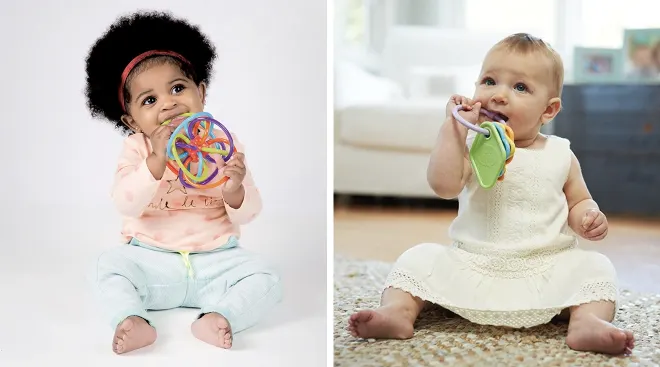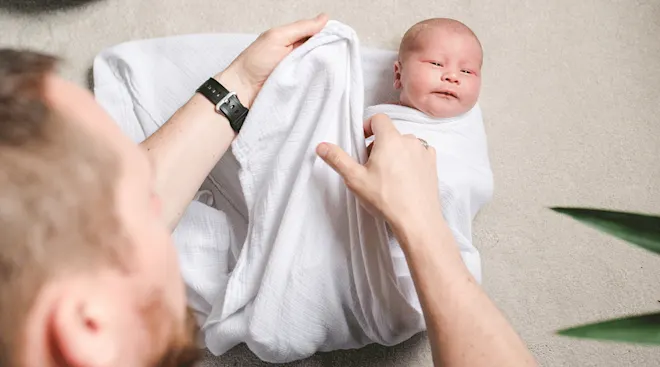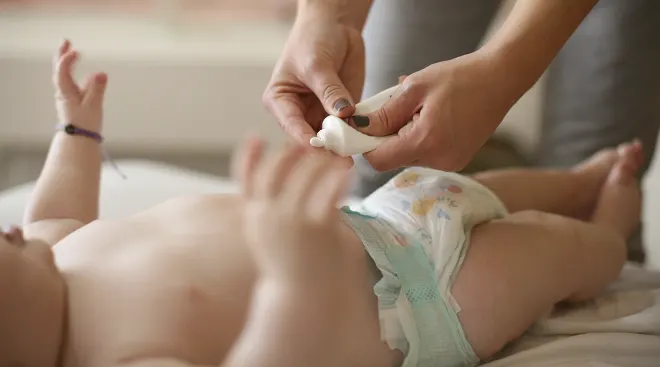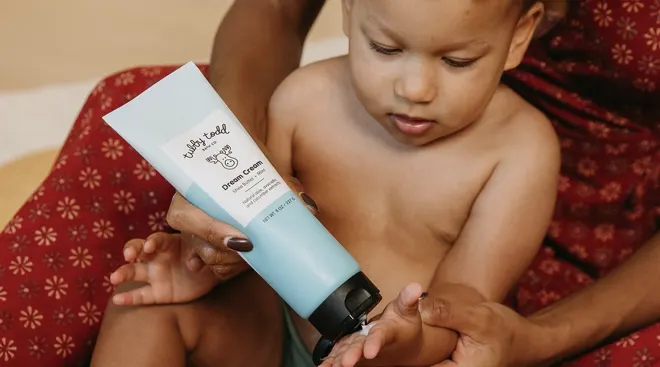The Truth About the Safety of Amber Teething Necklaces
Teething can be really tough on babies (and parents). Like all tricky stages of development, it doesn’t last forever, but that’s little comfort at 2 a.m. as you scramble to soothe your hurting little one. Understandably, you’re looking for a way to keep baby comfortable as those little teeth work their way through—and online research or well-meaning friends may have recommended buying an amber necklace for teething. At first glance, a Baltic amber teething necklace for babies might have some appeal as a natural alternative to conventional teething medicine. But with unconvincing science, dubious claims to success and significant safety risks, giving baby an amber baby teething necklace isn’t something you want to take lightly. Keep reading to learn what pediatricians have to say about necklaces made with amber beads for teething.
First of all, amber isn’t really a true gemstone—it’s actually fossilized tree resin. Most amber teething jewelry, including necklaces, bracelets and anklets, are made from either raw or heat-treated and polished Baltic amber beads, which are strung together and individually knotted. The necklace can then be placed around baby’s neck (though doing so poses a whole host of safety issues). “Amber teething necklaces are made of amber and are marketed to relieve teething pain. Sellers of the necklaces make claims that when warmed by baby’s body temperature, the amber releases a pain-relieving substance that’s absorbed by the child and helps with teething pain,” says Dina DiMaggio, MD, a New York City-based pediatrician and clinical assistant professor of pediatrics at NYU Grossman School of Medicine.
Some people believe Baltic amber’s soothing properties come from the presence of succinic acid, a natural substance that’s said to act as a painkiller when absorbed by the body. The highest concentration of succinic acid is in the outer layers of the resin, which is why some people prefer the raw amber teething jewelry to heat-treated, which strips away the outer layer of resin during the polishing process. Retailers also claim the beads can stimulate the thyroid gland and, consequently, control drool and improve the immune system’s ability to reduce inflammation in the ears, throat, stomach and respiratory system, says Alexis Phillips-Walker, DO, a pediatrician based in Texas. To date, however, there has been no scientific evidence or research to corroborate these claims.
With the recent surge in popularity of Baltic amber teething necklaces and beads, many people are convinced that their amber baby teething necklace has solved their child’s teething problems. You can find plenty of anecdotal evidence after a simple Google search, but medical experts caution that these necklaces are not safe or effective. According to the American Academy of Pediatrics (AAP), the claims of amber necklaces for teething are not supported by any scientific research or evidence.
A common misconception around Baltic amber teething necklaces is that the amber beads themselves are designed for baby to bite on, which isn’t the case. In fact, an amber necklace for teething is only meant to be worn by baby so that the succinic acid can be absorbed by baby’s skin. While this key element is indeed present in amber, there is little evidence that it would be released when warmed to baby’s body temperature. Even if the succinic acid is drawn out by baby’s warmth, the FDA notes it’s in unknown quantities. In other words, there’s no way to know if there’s enough succinic acid within the amber teething necklace to successfully pass through the skin and into the body in a large enough concentration to do any healing work. And even if there was, the necklaces simply aren’t worth the risk they pose to infants.
Many parents recoil from the idea of putting jewelry—especially necklaces—on babies because of choking and strangulation risks. Manufacturers of amber necklaces for teething claim that their products are safe because they knot each bead separately or design the necklace to snap if pulled too hard, thus reducing the risk of strangulation. However, even when individually knotted, if the thread breaks, baby will be able to pick up at least one bead and put it in their mouth—and the experts say that’s just one too many. Other companies have tried to quell parents’ fear of baby choking by selling amber teething beads to be worn around the wrist or ankle. But this arguably makes it even easier for babies to grab and pull at the anklet or bracelet and break the thread.
“Amber teething necklaces are dangerous and not recommended by pediatricians,” DiMaggio says. “The FDA released a warning in December 2018 after receiving reports of children choking on beads that break off and even the death of a toddler being strangled by the necklace while sleeping.”
Back in 2010, the Canadian federal public health department released cautionary guidance about amber necklaces for teething, and Ireland took an even more assertive line in 2015, with the Health Service Executive referring to amber teething necklaces for babies as being inherently unsafe. In 2016, the AAP issued its own warning, stating that the org advises against jewelry of any kind for infants.
There are so many alternative teething relief options that you can provide for your child without the risk that amber baby teething necklaces carry. “Try cold items on gums such as a frozen, damp washcloth or semi-frozen teething rings. (Teething rings that are frozen solid are too hard for babies),” Phillips-Walker says. She also recommends parents use chew toys and rubber teething rings, or massage baby’s gums with their (clean) fingers. Another option, if approved by your pediatrician, is offering a dose of acetaminophen (Tylenol) or ibuprofen. When it comes to numbing gels though, you want to avoid ones with benzocaine to avoid poisoning younger children, she adds.
Frequently Asked Questions
Are amber teething necklaces legal?
Technically, it’s still legal to sell amber necklaces for teething in the United States, however more and more organizations are taking strong stance and actions against them. As noted, in 2018, the FDA issued a warning against children using them, citing choking and strangulation, to combat marketing efforts by retailers and manufacturers. As a result, some platforms, including Etsy have banned the sale of such items on their sites.
Can babies sleep with amber necklaces for teething?
Per the AAP, babies and young children should never wear, let alone sleep with, amber teething necklaces or any other type of jewelry due to the risk of strangulation, choking and difficulty breathing.
Teething can be hard on the whole family—baby is in pain and there’s not much you can do to help aside from offer them comfort. But as desperately as you want baby to feel better, know that amber teething necklaces pose significant danger and no proof of reward.
Please note: The Bump and the materials and information it contains are not intended to, and do not constitute, medical or other health advice or diagnosis and should not be used as such. You should always consult with a qualified physician or health professional about your specific circumstances.
Plus, more from The Bump:
Dina DiMaggio, MD, a spokesperson for the American Academy of Pediatrics, is a pediatrician with Pediatric Associates of NYC and a clinical assistant professor in the department of pediatrics at NYU Grossman School of Medicine in New York City. She is also the co-author of The Pediatrician’s Guide to Feeding Babies and Toddlers: Practical Answers to Your Questions on Nutrition, Starting Solids, Allergies, Picky Eating, and More. She earned her medical degree from Albert Einstein College of Medicine in 2002.
Alexis Phillips-Walker, DO, is a pediatrician with Children’s Memorial Hermann Pediatrics Atascocita in Atascocita, Texas. She is a graduate of Ohio University Heritage College of Osteopathic Medicine.
Healthy Children (American Academy of Pediatrics), Teething Necklaces and Beads: A Caution for Parents, December 2018
Food and Drug Administration (FDA), FDA warns about safety risks of teething necklaces, bracelets to relieve teething pain or to provide sensory stimulation, December 2018
Health Canada, Necklaces for Preventing or Reducing Teething Pain, September 2010
Health Service Executive, Your baby and teething, February 2022
Etsy Community, Why Can't Amber Stones be Listed on Etsy?, June 2024
Learn how we ensure the accuracy of our content through our editorial and medical review process.
Navigate forward to interact with the calendar and select a date. Press the question mark key to get the keyboard shortcuts for changing dates.





















































